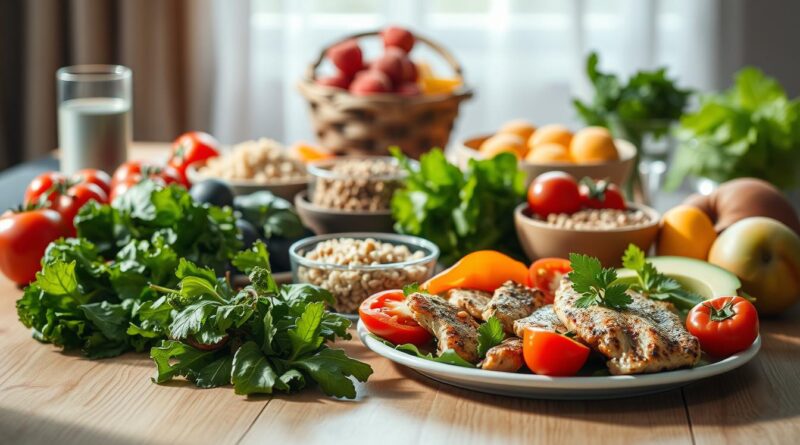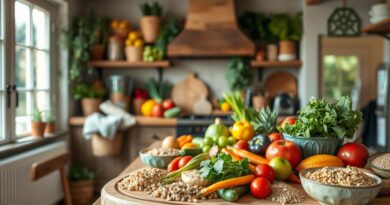The Ultimate Daily Diet Plan for Effective Weight Loss
Starting a weight loss journey can feel scary. But with a good meal plan, it gets easier. A daily diet plan for effective weight loss made just for you helps you eat right and keeps you on track to lose weight.

Following a structured meal plan can help you lose weight and eat better for life. This guide will show you how to make a great daily diet plan for weight loss. You’ll gain the tools and knowledge to win.
Key Takeaways
- Understanding the importance of a structured meal plan for weight loss
- Learning how to create a daily diet plan tailored to your needs
- Discovering healthy eating habits to support long-term weight loss
- Exploring meal planning strategies for effective weight management
- Gaining insights into the benefits of a well-balanced diet for overall health
Understanding the Science Behind Weight Loss
Weight loss is all about balance. It’s about burning more calories than you eat. How fast your body burns calories, and your overall health affect this balance.
Caloric Deficit: The Foundation of Weight Loss
A caloric deficit occurs when you burn more calories than you eat. This causes your body to use fat for energy, and it’s the key to losing weight.
How to Calculate Your Daily Caloric Needs
To lose weight, you must know how many calories you should eat daily. You can use the Harris-Benedict Equation to find your basal metabolic rate (BMR). Then, adjust it to see how active you are to get your total daily energy expenditure (TDEE).
For instance, if your TDEE is 2,500 calories, eating 2,000 calories daily can help you lose weight.
Metabolism and Its Role in Weight Management
Metabolism is essential for managing weight. It’s how your body turns food into energy. If your metabolism is fast, you burn more calories even when not moving.
Factors That Affect Metabolic Rate
Many things can change how fast your metabolism is. These include:
- Age: Metabolism slows down as you get older.
- Muscle Mass: Having more muscle means a faster metabolism.
- Genetics: Your genes can affect how well your body burns calories.
- Hormonal Balance: Hormones like thyroid hormone greatly affect your metabolism.
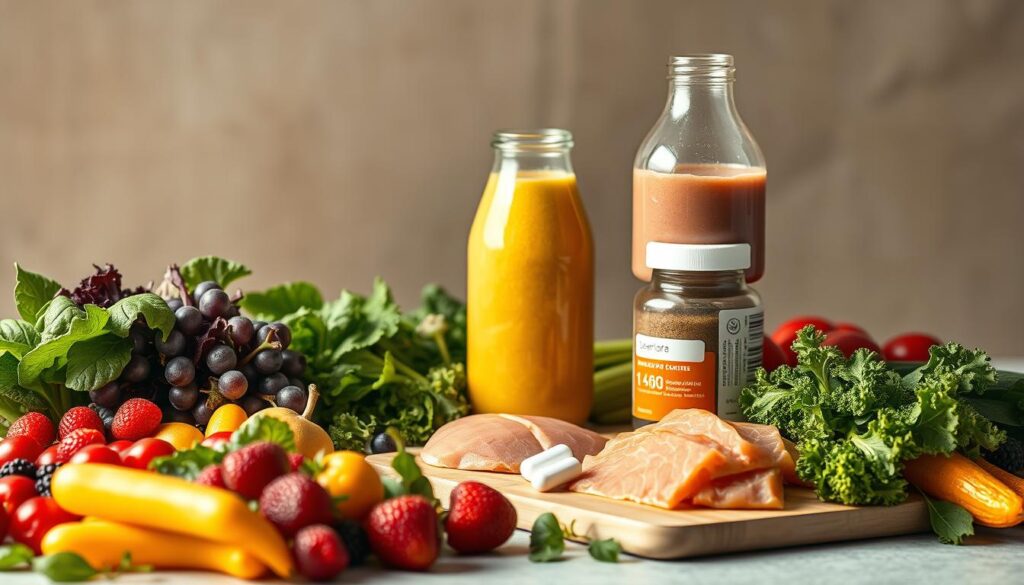
Key Principles of a Successful Weight Loss Diet
A good weight loss diet has a few key points. Following these can help you lose weight for good. Knowing and using these tips can change your weight loss journey.
Balanced Macronutrient Distribution
A balanced diet is key. It should have the right mix of proteins, carbs, and fats. Optimal ratios for fat loss vary, but balance is best.
Optimal Ratios for Fat Loss
To lose weight, eat more protein to keep your muscles strong. Keep carbs and fats in check. This makes slimming meal ideas that are good and filling.
Portion Control Strategies
It’s essential to control how much you eat. Use small plates and watch your serving sizes. This way, you eat the right food for weight loss without feeling hungry.
Meal Timing and Frequency
When and how often you eat matters. Some people eat small meals often to stay full and boost their metabolism.
The Truth About Intermittent Fasting
Intermittent fasting is popular for losing weight. It means fasting or eating less, then eating freely.

Using these diet tips, you can make slimming meal ideas to help you lose weight.
Daily Diet Plan for Effective Weight Loss
To lose weight effectively, it’s essential to understand key nutrients and follow well-balanced diet plans for weight loss that fuel your body and support healthy fat reduction.
Protein: Your Weight Loss Ally
Protein is key for losing weight. It helps build and fix muscles. Eating a lot of protein also makes you feel full, so you don’t overeat.
Best Protein Sources for Dieters
Good protein sources are lean meats like chicken and turkey. Fish, eggs, tofu, and legumes are also great. Adding these to your meals can help you reach your weight loss goals.
Healthy Fats That Support Fat Loss
Healthy fats are found in avocados, nuts, and olive oil. They help produce hormones and keep you full, which can help you lose fat.
Complex Carbohydrates vs. Simple Sugars
Complex carbs like whole grains and veggies give you energy for a long time. They also have fibre. On the other hand, simple sugars make your blood sugar go up and down. This makes you hungry again.
Fiber’s Role in Weight Management
Fibre is essential for managing weight. It makes you feel full and helps your digestion. Fruits, veggies, and whole grains are rich in fibre.
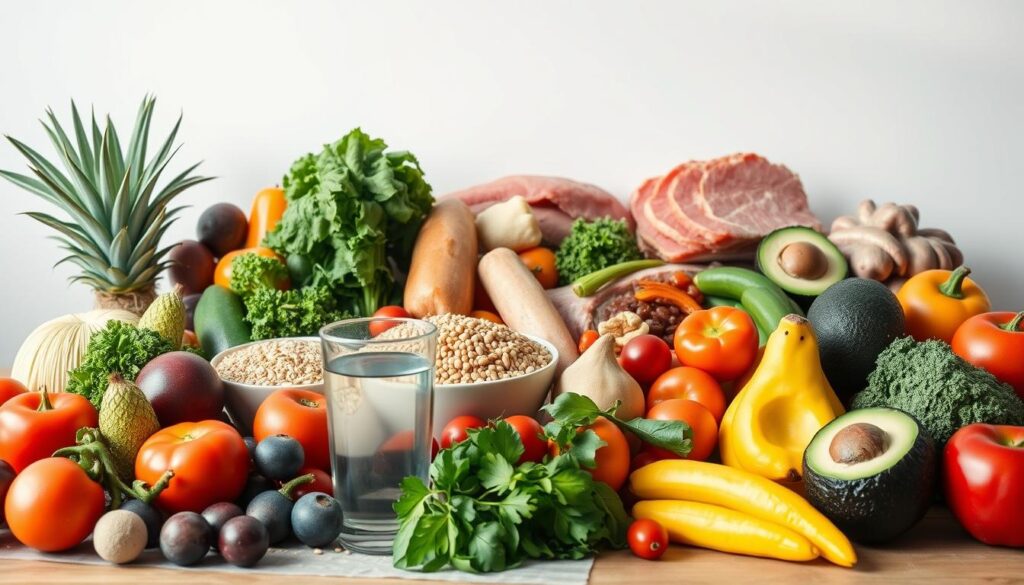
Designing Your Weight Loss Meal Plan
To lose weight well, you need a meal plan that fits you. A good meal plan examines your calorie needs, body type, and diet limits. It helps you lose weight in a balanced and lasting way.
Calculating Your Caloric Needs
The first step is determining how many calories you need each day. You must know your basal metabolic rate (BMR) and adjust it for your activity level. A caloric deficit is key for losing weight, so knowing how many calories you should eat to reach your goals is essential.
Adjusting Macronutrients for Your Body Type
Everyone’s body is different, and so are their needs for macronutrients. For example, some people need more protein. Changing your macronutrient ratios can help you lose weight better. A good mix includes protein, healthy fats, and complex carbs.
Customizing for Dietary Restrictions
If you have dietary limits, you must tailor your meal plan. This means vegetarian and vegan weight loss options that use plant-based proteins and foods full of nutrients.
Vegetarian and Vegan Weight Loss Options
Vegetarian and vegan diets can be great for losing weight if done right. Eating a variety of plant-based proteins like legumes, beans, and tofu, along with lots of veggies and whole grains, makes for a healthy diet.
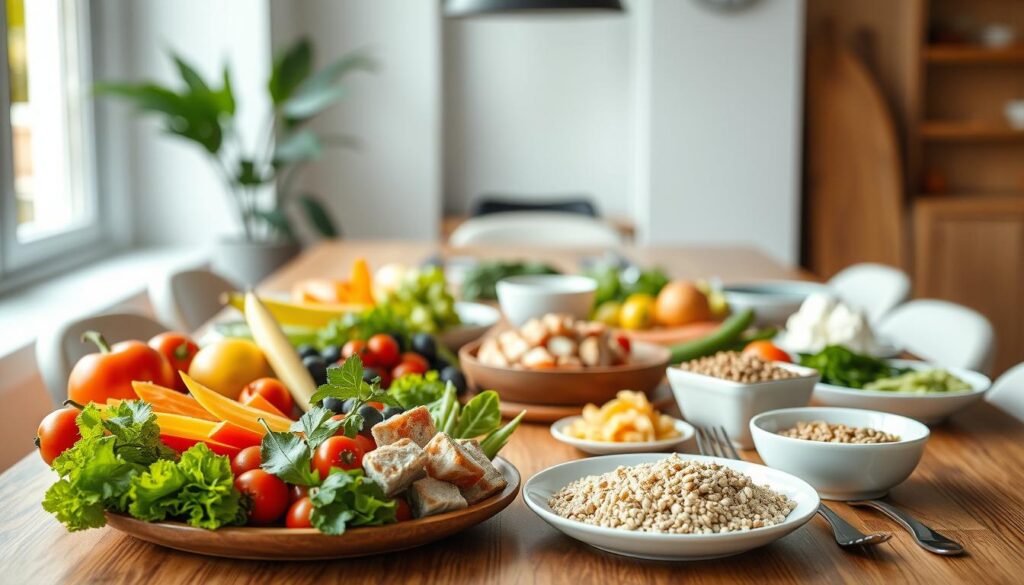
By thinking about these points and making your meal plan fit, you can have a daily diet plan for weight loss that works and lasts.
A 7-Day Daily Diet Plan for Weight Loss
A good seven-day diet plan is key to losing weight healthily. It will have many slimming meal ideas and food for weight loss. This way, you’ll stay full while losing weight.
Breakfast Options That Boost Metabolism
Starting with a healthy breakfast is essential for losing weight. It gets your metabolism going and gives you energy for the day.
Satisfying Lunch Ideas Under 500 Calories
Lunch should be filling but not too heavy. Try grilled chicken salads or whole grain wraps with lean turkey. They’re great choices.
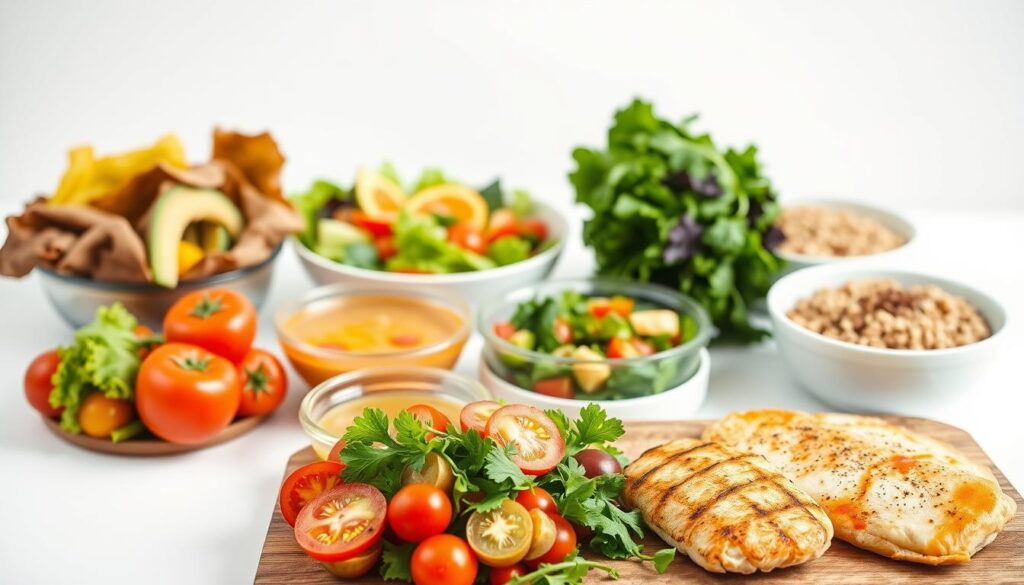
| Meal | Calories | Protein Content |
| Grilled Chicken Salad | 350 | 35g |
| Whole Grain Wrap with Lean Turkey | 420 | 30g |
| Quinoa and Vegetable Bowl | 450 | 15g |
Light Yet Filling Dinner Recipes
Dinner should be light to help you sleep well. Try salmon with roasted vegetables or a lentil soup.
Strategic Snacking for Weight Management
Snacking is essential for weight loss. It helps keep hunger away and stops you from overeating.
Emergency Snacks for Intense Cravings
For intense cravings, grab raw nuts or fresh fruits. They’re healthy and can stop your hunger.
Adding these meals and snacks to your daily life will make you closer to your weight loss goals.
Superfoods to Incorporate in Your Weight Loss Journey
To lose weight, eat superfoods full of nutrients but low in calories. These foods give your body what it needs and help you lose weight. They also make you feel full and boost your metabolism.
Metabolism-Boosting Foods
Some foods make your body burn more calories. Green tea, citrus fruits, and whole grains are good examples. Eating these can help you lose weight by speeding up your metabolism.
Hunger-Suppressing Natural Options
Some superfoods make you feel full and stop you from snacking too much. Chia seeds, almonds, and Greek yoghurt are great because they are full of fibre and protein. They keep you feeling full for a long time.
Appetite Control Through Food Choices
Foods high in fibre and protein help control hunger. Eating these foods can help you manage your weight better. For example, eating a protein-rich breakfast can keep you full all morning.
Nutrient-Dense, Calorie-Light Choices
Leafy greens, broccoli, and bell peppers are low in calories but full of nutrients. They are perfect for a weight loss diet. They give you essential vitamins and minerals without adding too many calories.
| Superfood | Nutritional Benefits | Calories per Serving |
| Chia Seeds | High in Fiber and Omega-3 | 100 |
| Green Tea | Antioxidants, Metabolism Boost | 0 |
| Broccoli | Rich in Vitamins C and K | 55 |
Eating these superfoods can help you lose weight and get healthier. Remember, losing weight is not just about eating less. It’s also about eating the right foods to nourish your body.
Hydration and Weight Loss: The Overlooked Connection
Drinking enough water is key to losing weight. It’s good for health and for losing fat.
Optimal Daily Water Intake
Drinking water boosts your metabolism. It helps your body burn fat naturally. Aim for eight glasses daily, but adjust based on your activity and size.
Hydrating Foods and Their Benefits
Eating hydrating foods, such as cucumbers, celery, and watermelon, also helps. These foods are full of water and provide important nutrients.
- Cucumbers: Rich in water and antioxidants
- Celery: Low in calories, high in water content
- Watermelon: High water content and rich in vitamins
Beverages to Avoid During Weight Loss
Some drinks can stop you from losing weight. They have too many calories and sugar. Avoid sugary sodas, energy drinks, and sweetened teas or coffees.
Hidden Calories in Popular Drinks
Many drinks have hidden calories. These calories can add up fast. For example:
| Beverage | Calories per Serving |
| Sugary Soda (12 oz) | 150-200 calories |
| Energy Drink (8 oz) | 80-120 calories |
| Sweetened Coffee Drink (16 oz) | 200-400 calories |
Choose your drinks wisely to help with weight loss and keep your diet healthy and balanced.
Meal Prep Strategies for Weight Loss Success
Meal prep is key to weight loss. It helps you eat the right foods and avoid bad choices, fueling your body well.
Time-Saving Preparation Techniques
Finding time for meal prep can be hard. One-Hour Prep for a Week of Healthy Eating is a great solution.
One-Hour Prep for a Week of Healthy Eating
- Set aside one hour on the weekend for meal prep.
- Make different meals that you can mix and match all week.
- Choose simple, healthy recipes that can be made in big batches.
Storage Solutions for Healthy Meals
It’s important to store meals properly. Use airtight containers and label them with dates. This will keep your meals fresh and safe.
Batch Cooking for Busy Lifestyles
Batch cooking is perfect for busy people. It means cooking a lot of one thing or a whole meal at once, which saves time and reduces waste.
Using these meal prep tips can help you lose weight. It also saves you time and reduces stress.
Navigating Common Diet Challenges
Going on a weight loss diet is more than just eating right. You need ways to beat everyday problems. Knowing how to handle these issues is key to success.
Managing Cravings Effectively
Cravings can stop you from losing weight. It’s essential to understand why you crave certain foods.
Psychology Behind Food Cravings
Cravings often come from feelings, not hunger. Figuring out why you crave certain foods helps. For example, stress might make you crave snacks. Try stress-reducing activities like meditation or yoga.
Dining Out Without Derailing Progress
Eating out can be difficult when you’re trying to lose weight. Plan by choosing restaurants with healthy options and being careful with how much you eat.
Social Situations and Holiday Eating
Food is a big part of social events and holidays. A good idea is to bring a healthy dish to share. This way, you know there’s something good for you. Also, watch your drink intake and eat in moderation.
Using these tips, you can handle diet challenges and keep your weight loss goals in sight.
Combining Your Diet Plan with Physical Activity
For effective weight loss, you need a diet plan and exercise. A daily diet plan is a good start, but the right exercise can improve your results.
Exercise Types That Complement Weight Loss Diets
Many exercises help with weight loss. These include:
- Cardio exercises like running, cycling, or swimming
- Resistance training to build muscle
- High-Intensity Interval Training (HIIT) for burning calories
Timing Nutrition Around Workouts
It’s essential to eat right before and after working out. This helps you perform better and recover faster. Eat a meal or snack with protein and carbs.
Adjusting Caloric Intake Based on Activity Level
When you’re more active, you might need more calories. The table below shows how much more you might need:
| Activity Level | Caloric Adjustment |
| Sedentary | No change |
| Moderately Active | +250 calories |
| Very Active | +500 calories |
Mixing slimming meal ideas with exercise lets you lose weight better and keep it off.
Conclusion: Sustaining Your Weight Loss Results
Reaching weight loss goals is a big win, but maintaining those results is just as important. By sticking to a good meal plan, you can keep losing weight and staying healthy for a long time. Making healthy meals a part of your life is key to keeping weight off.
To keep losing weight, keep using the tips from this guide. This means eating the right mix of foods, controlling how much you eat, and staying active. This way, you can enjoy your meal plans and move towards a healthier life.
Healthy meal planning is more than just losing weight. It’s about living a healthy life for good. You can keep your weight loss strong by choosing smart foods and staying true to your goals.
FAQ
What is a daily diet plan for weight loss?
A daily diet plan for weight loss helps you eat less and better. It makes sure you get the right amount of food for your body. It also includes foods that are good for you.
How do I calculate my daily caloric needs for weight loss?
To determine how many calories you need, consider your age, sex, weight, height, and level of activity. Losing 1-2 pounds a week is safe. This means you need to eat 500-1000 calories less each day.
What are the key principles of a successful weight loss diet?
A good weight loss diet has the right mix of food. It’s about eating the right amount and at the right time. Eating foods high in protein, healthy fats, and complex carbs helps too.
How can I customize a weight-loss meal plan for my dietary needs?
To make a meal plan that fits you, consider what you can’t eat. If you’re a vegetarian or vegan, adjust the food mix. Also, consider your body type and change your food mix.
What are some healthy meal-planning strategies for weight loss?
Healthy meal planning means preparing meals ahead of time and cooking in batches. Adding foods that help you lose weight is also good. Drinking enough water and eating foods that help you stay hydrated also helps.
How can I manage cravings and stay on track with my weight loss diet?
Managing cravings means understanding why you want certain foods. It’s about choosing snacks that are good for you but not too many calories.
Can I still enjoy dining out while following a weight-loss diet?
Yes, you can still go out to eat and lose weight. Just pick foods that are good for you and eat the right amount.
How do I adjust my caloric intake based on my activity level?
Think about your workouts to adjust your calories based on your activity level. Make sure you eat the right foods before and after exercising.
Read More
Intermittent Fasting Diet Plan for Beginners: Get Started Today

